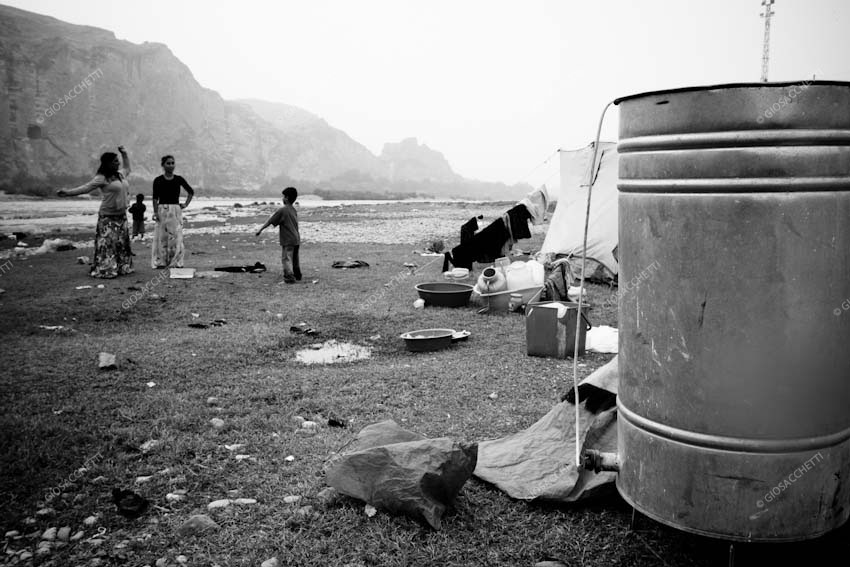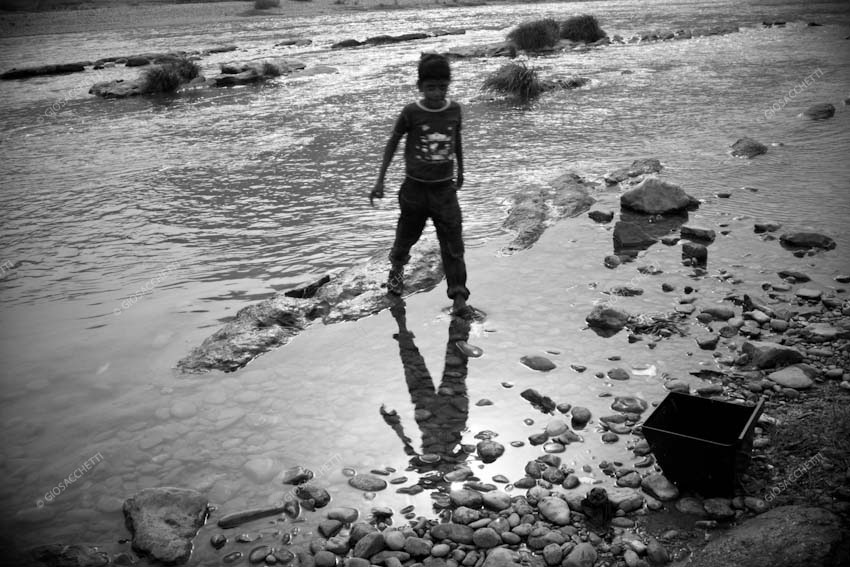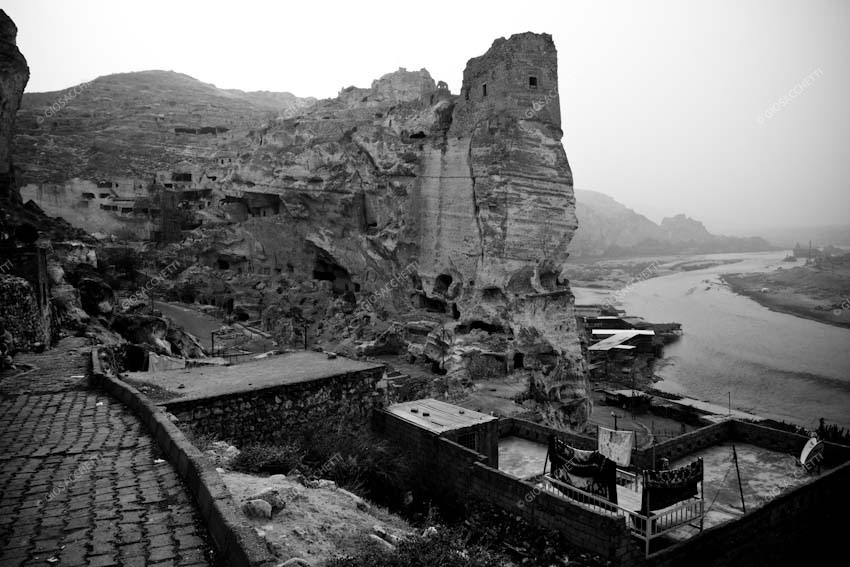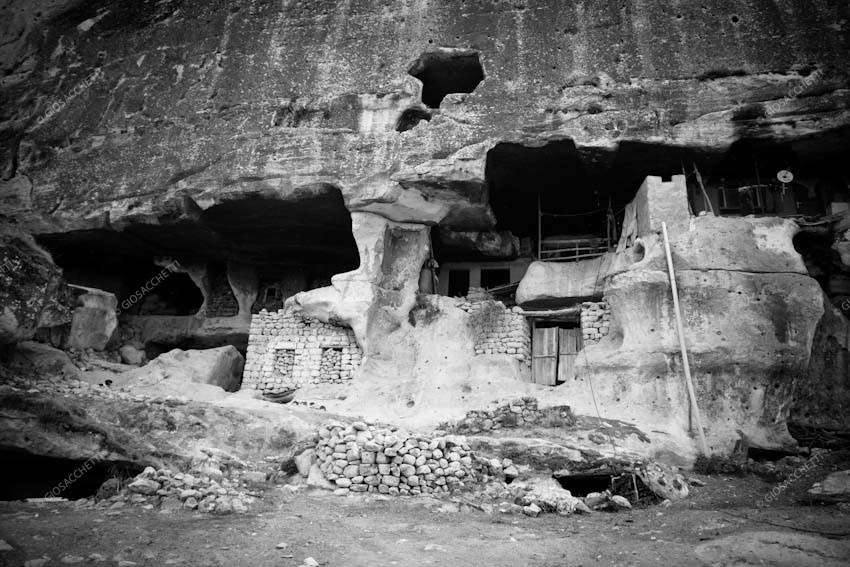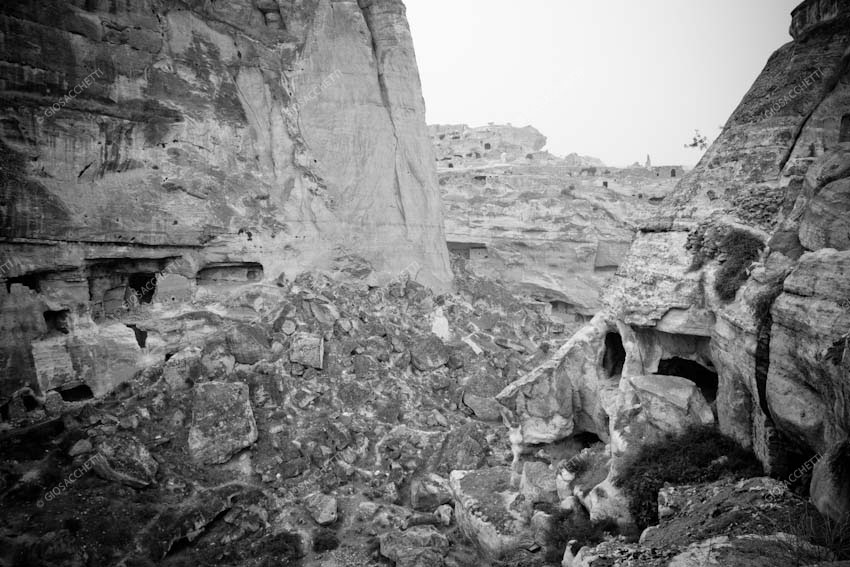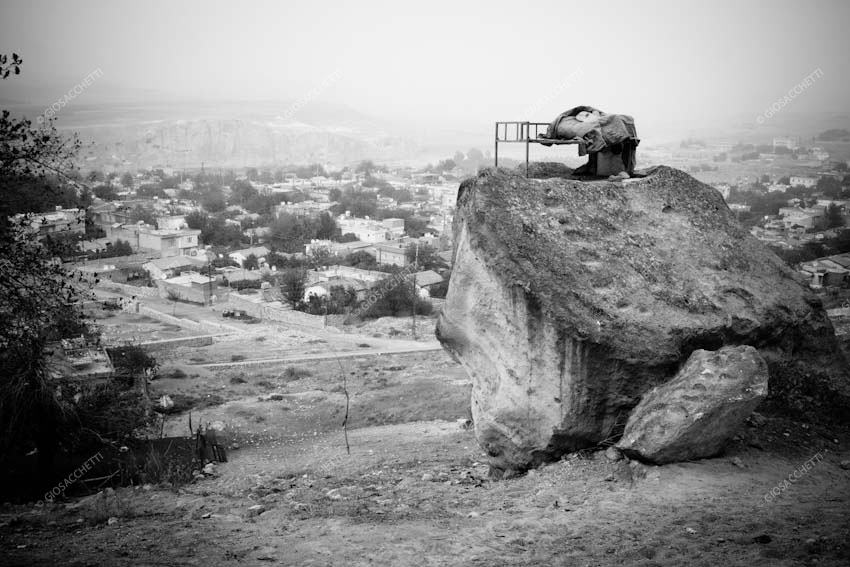HOME > PORTFOLIO > STORIES > KILLER WATER
click the photo above to view the next image
KILLER WATER
In South-East Anatolia is a real hydrological distortion going on, with the construction of dams on the part of Turkey. This intentionality has been perpetuated by destroying the history, daily life and the future of turkish villages of Kurdistan, with the construction of already eleven dams and the consequent evacuation of three hundred and fifty thousand people. GAP (Southeastern Anatolia Project GAP), is the project of construction of dams in Kurdistan turkish; so far made 11, 22 according to the plan; of 19 hydroelectric facilities, 9 of which have already been built, the billions allocated 25, 20 already spent; In essence, the dams increase the level of kilometers of water, submerging entire land and homes.
The solution of the dam, intended to encourage the growth of agricultural areas is fake, because the closed cycle of water increases the salinity of the course, which is a problem for the irrigation of fields. The thirty-year war involving the Kurds in Turkey should be examined more profoundly together with de-legitimization of this population. The construction of these dams brings the evacuation of occupied territories for the majority Kurdish population, creating a sort of control over areas organized and developed by Kurds. To manage the currents from the Tigre and Euphrates, born in Kurdistan and which are not to be destinated to the Kurds is the true paradox.
During the '90s, the Turkish security forces have systematically destroyed 3,349 Kurdish villages and made refugees more than two million six hundred thousand Kurds, Assyrian-Christians with them, including Aramaic. Until now, the Turkish authorities have refused the reconstruction of the country, indeed, with the construction of the Ilisu Dam, more than 313 square miles of land along the Tigris would be flooded. Among them also a part of the archaeological and historical site of Hasankeyf, which dates back 12 thousand years ago and meets nine of the ten criteria of World Heritage Sites. Hasankeyf is perhaps the most important center for the Kurdish culture, place of pilgrimage for over thirty thousand people a year.
Nel Sud-Est dell'Anatolia è in atto un vero e proprio stravolgimento idrologico, con la costruzione delle dighe, da parte della Turchia. Quest'intenzionalità è già stata perpetuata, distruggendo la storia, la quotidianità ed il futuro di villaggi del Kurdistan turco, con l'edificazione di già undici dighe e la conseguente evacuazione di trecentocinquantamila persone. GAP (GAP Southeastern Anatolia Project), è il progetto di costruzione delle dighe nel Kurdistan turco; 11 fin'ora realizzate, 22 secondo il piano; istallazioni di 19 centrali idroelettriche di cui 9 già costruite; 25 i miliardi stanziati, 20 già spesi; In sostanza le dighe aumentano di chilometri il livello d'acqua, sommergendo interi terreni, abitazioni, villaggi.
La soluzione della diga volta ad incentivare la crescita agricola delle zone è fasulla, perché la chiusura del ciclo d'acqua aumenta la salinità del corso, il che è un problema per l'irrigazione dei campi. Andrebbe approfondita la guerra trentennale che coinvolge i curdi presenti in Turchia, con delegittimazioni di quest'etnia. La costruzione di queste dighe procura lo sgombero di territori occupati per la maggioranza da popolazione curda, creando una sorta di controllo su zone organizzate e sviluppate da curdi. Gestire correnti provenienti dal Tigre e dall'Eufrate, nati nel Kurdistan e non destinati alle popolazioni curde è il vero paradosso.
Durante tutti gli anni '90, le forze di sicurezza turche hanno distrutto sistematicamente 3.349 villaggi kurdi e reso profughi più di due milioni e seicentomila Kurdi, con essi anche Cristiani assiro-aramaici. Fino ad oggi le autorità turche hanno rifiutato la ricostruzione dei paesi, anzi, con la costruzione della diga di Ilisu, più di 313 Km quadri di terreno lungo il Tigri verrebbero inondati. Tra essi anche parte del sito archeologico e storico di HASANKEYF, che risale a 12 mila anni fa e che soddisfa nove dei dieci criteri del Patrimonio Mondiale UNESCO. Hasankeyf è forse il centro più importante per la cultura curda, mèta di pellegrinaggio per oltre trentamila persone l'anno.
The solution of the dam, intended to encourage the growth of agricultural areas is fake, because the closed cycle of water increases the salinity of the course, which is a problem for the irrigation of fields. The thirty-year war involving the Kurds in Turkey should be examined more profoundly together with de-legitimization of this population. The construction of these dams brings the evacuation of occupied territories for the majority Kurdish population, creating a sort of control over areas organized and developed by Kurds. To manage the currents from the Tigre and Euphrates, born in Kurdistan and which are not to be destinated to the Kurds is the true paradox.
During the '90s, the Turkish security forces have systematically destroyed 3,349 Kurdish villages and made refugees more than two million six hundred thousand Kurds, Assyrian-Christians with them, including Aramaic. Until now, the Turkish authorities have refused the reconstruction of the country, indeed, with the construction of the Ilisu Dam, more than 313 square miles of land along the Tigris would be flooded. Among them also a part of the archaeological and historical site of Hasankeyf, which dates back 12 thousand years ago and meets nine of the ten criteria of World Heritage Sites. Hasankeyf is perhaps the most important center for the Kurdish culture, place of pilgrimage for over thirty thousand people a year.
Nel Sud-Est dell'Anatolia è in atto un vero e proprio stravolgimento idrologico, con la costruzione delle dighe, da parte della Turchia. Quest'intenzionalità è già stata perpetuata, distruggendo la storia, la quotidianità ed il futuro di villaggi del Kurdistan turco, con l'edificazione di già undici dighe e la conseguente evacuazione di trecentocinquantamila persone. GAP (GAP Southeastern Anatolia Project), è il progetto di costruzione delle dighe nel Kurdistan turco; 11 fin'ora realizzate, 22 secondo il piano; istallazioni di 19 centrali idroelettriche di cui 9 già costruite; 25 i miliardi stanziati, 20 già spesi; In sostanza le dighe aumentano di chilometri il livello d'acqua, sommergendo interi terreni, abitazioni, villaggi.
La soluzione della diga volta ad incentivare la crescita agricola delle zone è fasulla, perché la chiusura del ciclo d'acqua aumenta la salinità del corso, il che è un problema per l'irrigazione dei campi. Andrebbe approfondita la guerra trentennale che coinvolge i curdi presenti in Turchia, con delegittimazioni di quest'etnia. La costruzione di queste dighe procura lo sgombero di territori occupati per la maggioranza da popolazione curda, creando una sorta di controllo su zone organizzate e sviluppate da curdi. Gestire correnti provenienti dal Tigre e dall'Eufrate, nati nel Kurdistan e non destinati alle popolazioni curde è il vero paradosso.
Durante tutti gli anni '90, le forze di sicurezza turche hanno distrutto sistematicamente 3.349 villaggi kurdi e reso profughi più di due milioni e seicentomila Kurdi, con essi anche Cristiani assiro-aramaici. Fino ad oggi le autorità turche hanno rifiutato la ricostruzione dei paesi, anzi, con la costruzione della diga di Ilisu, più di 313 Km quadri di terreno lungo il Tigri verrebbero inondati. Tra essi anche parte del sito archeologico e storico di HASANKEYF, che risale a 12 mila anni fa e che soddisfa nove dei dieci criteri del Patrimonio Mondiale UNESCO. Hasankeyf è forse il centro più importante per la cultura curda, mèta di pellegrinaggio per oltre trentamila persone l'anno.

